Bhutan in the Himalayas, a perfect 9-day itinerary
A west Bhutan trip through the 4 valleys of Paro, Thimphu, Punakha & Phobjikha:
Buthan, the mystic kingdom in the Himalayas, is something very special. You will not find another like it! After sharing a travel guide with you in my last post, here is the perfect Bhutan 9-day itinerary how to explore the otherworldly Land of the Thunder Dragon. The journey goes to Buthan’s heartland, the four valleys of Paro, Thimphu, Punakha and Phobjikha. This is the west of the country that most of the travelers see. And this for good reason. It is home to the only international airport, the capital and has a great density of sights.
Before going into details about the places my husband and I visited, here is an overview on all my blogposts about Bhutan.
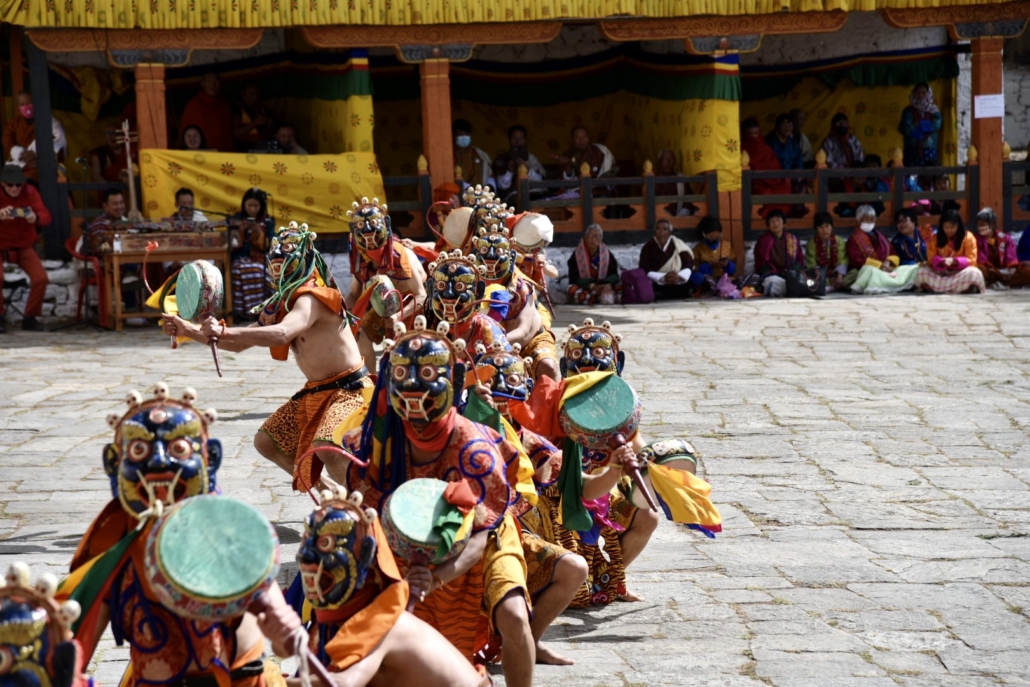
My mini series about Bhutan travel
As mentioned at the beginning, I already did a travel guide with all the essentials to know when planning to come to Bhutan. As to what will follow, there it is.
In my next post, I will outline how to travel the suggested itinerary via an arrangement by a luxury hotel. There are three international high-end hotel groups that operate in Druk Yul – that is how the locals call their home land. And I want to compare these three. Then I will provide information about traveling Bhutan with our choice of hotel. To end this mini series about the Land of the Thunder Dragon, I will inform about possible pre- and post-Bhutan stays. This because it is usually not possible to fly in directly from more distant countries.
Now to our perfect Bhutan 9-day itinerary.

My Google Map of a Bhutan 9-day itinerary
You find the Bhutan travel plan my husband and I followed in the form of a Google Map. It includes all the (luxury) hotels we stayed, a recommended restaurant we ate (there is only one as we had a full board package) and the things we did. One tip: to experience Bhutan at its most authentic, it is a good idea to throw in a few lesser visited sites and walks/hikes! As to the nature of attractions – the terminology – check out my travel guide.
In case you wonder about other things to do in west Bhutan than mentioned in my Bhutan 9-day itinerary, there are many more. Yet my husband and I had decided that we wanted to explore the four valleys by walking as much as possible. This is supposed to be the royal road to fully immerse into Druk Yul. Because that is what the locals do all the time, at least in the rural regions outside of Paro and Thimphu. I mentioned it in the description of the individual sights in case we walked/hiked to them.
From place to place in west Bhutan, a perfect 9-day itinerary
To begin, a short overview on our 9-night trip. We started and ended with two days in Paro each. The first stay consisted of general sightseeing, the second one was dedicated to the hike to the Tiger’s Nest. Next was the Punakha Valley, where we spent three days in subtropical surroundings. Before our return to Paro, we had two more days in the Phobjikha Valley. Here we delved even deeper into the country’s rural landscapes.

1. Paro Valley 2,200m/7,200ft (day 1&2, day 8&9), 1st & 4th stop Bhutan 9-day itinerary
This is where every visitor arriving by air starts his or her Bhutan journey. The charming town of Paro with a population of about 50,000 lies on the bank of the Paro river. From the impressive Paro Dzong

it is not far to its main street, only built in 1985. It is lined with colorful wooden buildings that all look more or less the same.

1.1. General sightseeing
1.1.1 Paro Dzong
One of the major sights here is the before mentioned Paro Dzong. It sits atop a hill, in a commanding position, overlooking the entire valley. It was constructed in the 17th century and is also called Rinpung Dzong, fortress of the jewel hill.

When my husband and I arrived in Paro at the beginning of April 2023, the Paro Tsechu Festival took place. This is considered as one of the country’s most important ones where masked dancers perform their art. We had not planned our trip around the festival, so we were just lucky of having the chance to attend. And it really was worth it! It was a colorful affair – from the dancers

to the audience

– and allowed us a unique cultural insight.
1.1.2. Walk/Hike to Zuri Dzong Monastery Paro/National Museum Paro
I dearly remember our first walk/hike starting at our hotel (COMO Paro) up the hill towards Zuri Dzong Monastery Paro.
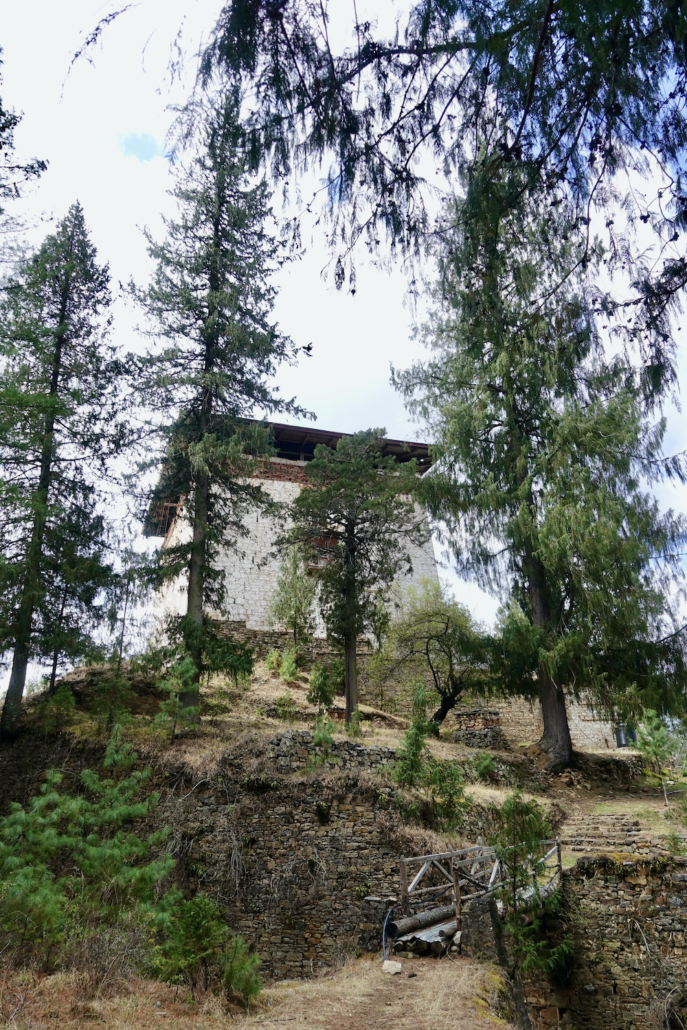
You need about half three quarters of an hour to reach it, walking through beautiful cypress and pine trees. It is one of the oldest dzongs, dating back to 1352. From here you have a stunning panoramic view of the Paro Valley

(we did not enter the premises).
The walk/hike can be continued in the direction of the National Museum, housed in an ancient watchtower, which requires another half hour. It offers a good introduction to the Buthanese heritage and traditions.
1.1.3. Other sights in Paro
If you have more time available, consider driving to Drukgyel Dzong Paro

northwest of Paro. You find another dzong a this spot, where the highway ends. It was erected to control the northern route to Tibet. For a long time, this dzong had been in ruins. Yet recently, it was completely rebuilt. In the time to come, it shall be opened to the public.
On your way back to Paro, make a stop at Kyichu Lhakhang Temple Paro.

It is one of the country’s oldest temples, built in the 7th century. There is a belief that the two orange trees in the courtyard bear fruit throughout the year.
1.2. Tiger’s Nest Monastery Paro Taktsang Hike
This is one of Bhutan’s most incredible sights, the monastery perched on the side of a sheer cliff 900 m/2,953 ft above the floor of the Paro Valley. Without a doubt, a first time trip to Bhutan would not be complete without seeing it!

The complex was built in 1692, around the cave where Guru Rinpoche first meditated. He is said to have brought the Buddhism from Tibet to Bhutan arriving here on the back of a tiger. Thus, giving this place the name “Tiger’s Nest”.
Getting here involves some effort, meaning an intermediate to difficult hike (700 m/2,297 ft up). Allow about five hours for this activity (including a one-hour temple tour). Start early in the morning to avoid crowds. Plan to leave the monastery around midday. At this time the lighting is ideal for photography. Anyone of average fitness can do this hike, just do not rush it!

2. Thimphu Valley 2,248m/7,375ft (transit only)
I do not consider Bhutan’s capital of Thimphu Town as a must-see on your Bhutan trip. If you expect an idyllic town, you will be disappointed. The traditional houses are fast being replaced by multi-story high-rise buildings. And the town incessantly grows in all directions. As many other Asian countries, Bhutan suffers from rural exodus. Problematic in the case of Thimphu is it that there are by far not enough job opportunities for all the people coming from the countryside.
Be it as it may, there are still some sights you should not miss in Thimphu. We passed it twice on our way from Paro to Punakha and back (it is a bit more than a one-hour drive from Paro).
2.1. Buddha Dordenma Statue Thimphu
The huge 51 m/169 ft statute of Buddha Dordenma is located in a commanding position above Thimphu Town. It is made of bronze and gilded in gold, just as the over 100,000 smaller Buddha statues that come with the huge Buddha. The statue was made in China, cut in pieces and reassembled onsite. Its construction began in 2006 and ended in 2015. A businessman from Singapore sponsored the statue, which costed 100 million US$.

2.2. Traffic cop on Thimphu’s busiest intersection
Bhutan is probably the only country worldwide whose capital does not have a single traffic light. Instead, you find a traffic cop at Thimphu’s busiest intersection. He wears white gloves and directs the traffic in an artful way.
From what I learned, there used to be a traffic light at this spot. Yet it was a source of confusion for the road users. Consequently, it was abolished.
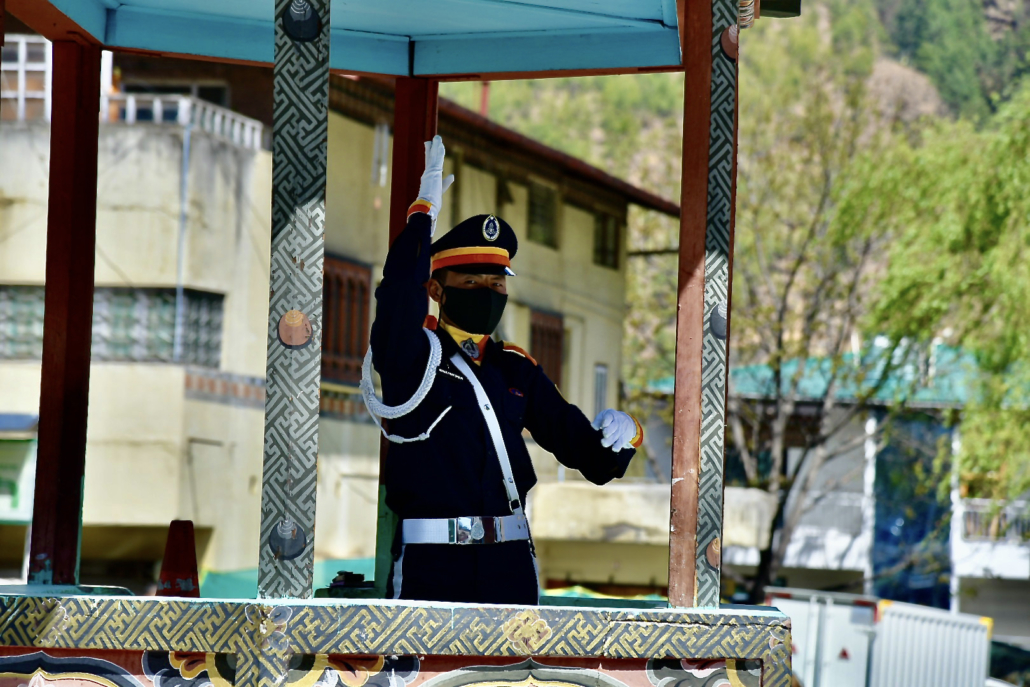
2.3. Simply Bhutan Living Museum
Simply Bhutan is an interactive living museum that gives a quick introduction to different aspects of traditional Buthanese life. You learn how Ara, the rice wine, is made, and you can also try it. They inform about the way they construct their houses. There is also the chance to give their national sport, archery, a shot. And you can watch women doing the typical festival dances while you sip traditional butter tea.
Although the whole thing is rather touristy, it is fun, and you need less than an hour to do the whole tour.

2.4. Dochula Pass
If you do not go to Punakha from Paro, it is still worth doing the trip to the nearby Dochula Pass (about a 45-minute drive from Thimphu). This, in particular, if it is a sunny and clear day. Then you have good chances to view the snow-covered Himalaya peaks from here (which are 7,000 m / 23,000 ft about sea level).

My husband and I crossed this mountain pass (3,100 m/10,300 ft) twice, but we had no luck with the weather, so no snow mountains for us. Yet, we had a look at the 108 memorial chortens (shrines) or stupas (tombs), built in 2004.

3. Punakha Valley 1,242m/4,075ft (day 3-5), 2nd stop Bhutan 9-day itinerary
You get to Punakha in a four- to five-hour drive from Paro. And you encounter a totally different world here. As it is at a lower elevation, it is warmer and has a subtropical climate. It is the main producer of rice, also the red one, which is nuttier in taste. And you find here also banana and orange trees.

Punakha is located at the banks of two beautiful rivers, Po Chhu (Male) and Mo Chhu (Female).

There is also the opportunity to do white-water rafting. The town used to be the country’s capital, until 1955. In terms of things to do in Punakha, there is a wide choice to choose from.
3.1. Khamsum Yulley Namgyal Chorten Punakha
Climbing the hill to this chorten or stupa – a religious monument – is a popular thing to do. You need about half an hour to do so, starting at a footbridge in Yepaisa Village. The chorten, built in 2004, was built to ward off negative forces and to spread peace and harmony to everyone. From its roof, you have a fabulous panorama vista of Punakha’s terraced fields.

3.2. Punakha Dzong
This dzong, erected in the 17th century, is arguably Bhutan’s most beautiful one. At the same time, it is the country’s second oldest and second largest one. And it is the winter home of Je Khenpo, the Chief Abbot, staying here with 1,000 monks. Punakha Dzong is also known under the name of the “palace of great happiness”

3.4. Chorten Nyingpo Lhakhang Punakha
Horten Nyingpo is a monastery in Kabisa, built in 17th century. You can reach it by car along a small, curvy road yet it is much more rewarding to hike up to this remote and lesser visited place. In such a way, you are most times in the forest, pass a village at some point and have great views of Punakha’s rice fields.
Once arrived – you need about 1 1/4 hour by foot from Hotel COMO Punakha – , do not “only” visit the monastery but also walk around a bit. View the property from further away, have a look at the picturesque surroundings and at the impressive archery ground in the adjacent village.

3.5. Other sights in Punakha
A popular monastery is Chimi Lhakhang Punakha, also known as fertility temple. This is easy to recognize from the motifs you find here. The temple was built in honor of the so-called “divine madman” who had an unorthodox way of teaching Buddhism and was fond of women, wine and dance.
The Sangchhen Dorji Lhuendrup Lhakhang Nunnery Punakha is a newly built nunnery constructed in traditional style (2010). It is located on a hill among pine trees, boasting breathtaking views of the Punakha Valley. It is a quiet and peaceful place, and everything is tidy too. 120 nuns live here at this Buddhist College.

The Punakha Suspension Bridge is one of Bhutan’s longest ones, measuring 180 m/590 ft. It is adorned with fluttering prayer flags. It spans over the “Male” river and seems quite stable. Having said that, the bridge may sway a bit when it is windy, and this is quite often.

4. Phobjikha Valley 3,000m/10,000ft (day 6&7), 3rd stop Bhutan 9-day itinerary
This contemplative valley is a great addition to make once you are in Punakha and having two more nights to spend before returning to Paro. You reach the Phobjikha Valley after a three- to four-hour drive from Punakha Valley crossing the Lawa La Pass (3,200 m/10,500 ft).
There is lots of agriculture (especially potato cultivation) in this bowl-shaped glacial valley on the western slopes of the Black Mountains. The area is also called Gangte or Gangtey Valley in reference to the Gangtey Goempa Monastery sitting on a ridge above the valley. As to sights here, there is much to to do here as to walking/hiking yet there are also some religious sites.
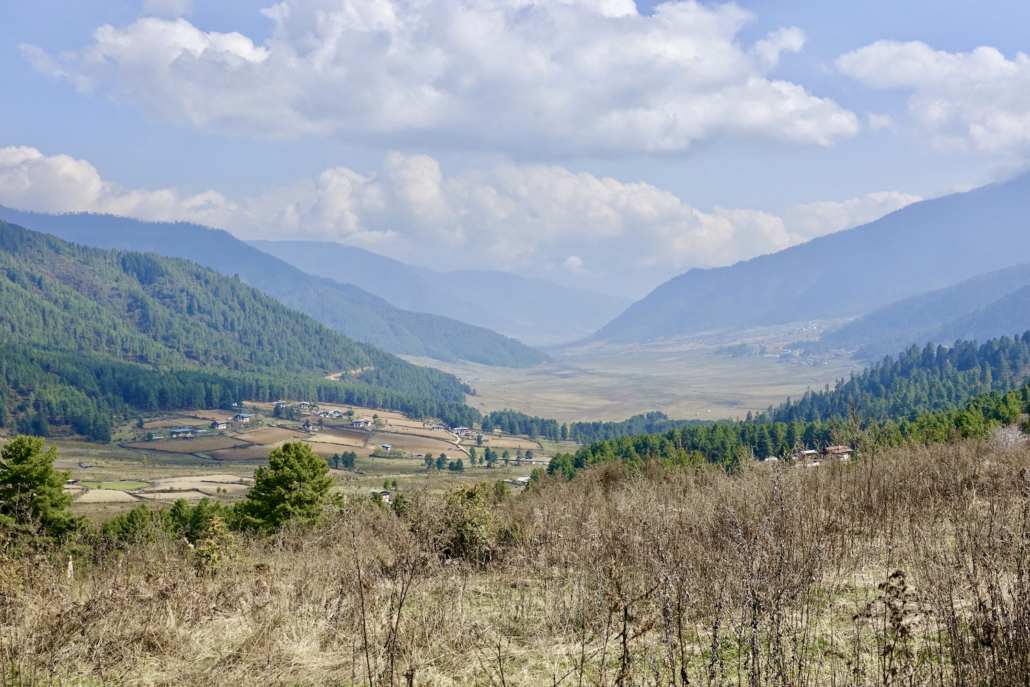
4.1. Black-Necked Crane Information Center Phobjikha Valley
The Phobjikha Valley is one of the most important wildlife preserves in the country due to the endangered black-necked cranes that winter here. To have a look at this bird – there are two injured ones in a cage – , go to the Black-Necked Crane Information Center. Here you find also informative displays about the black-necked cranes plus an educational 15-minute video. From October to mid-February, you can watch the birds from here feeding on the valley marshlands.

4.2. Walking/Hiking trails in Phobjikha Valley
There is a number of walking/hiking trails to undertake in this area known for its rhododendrons that bloom in spring.
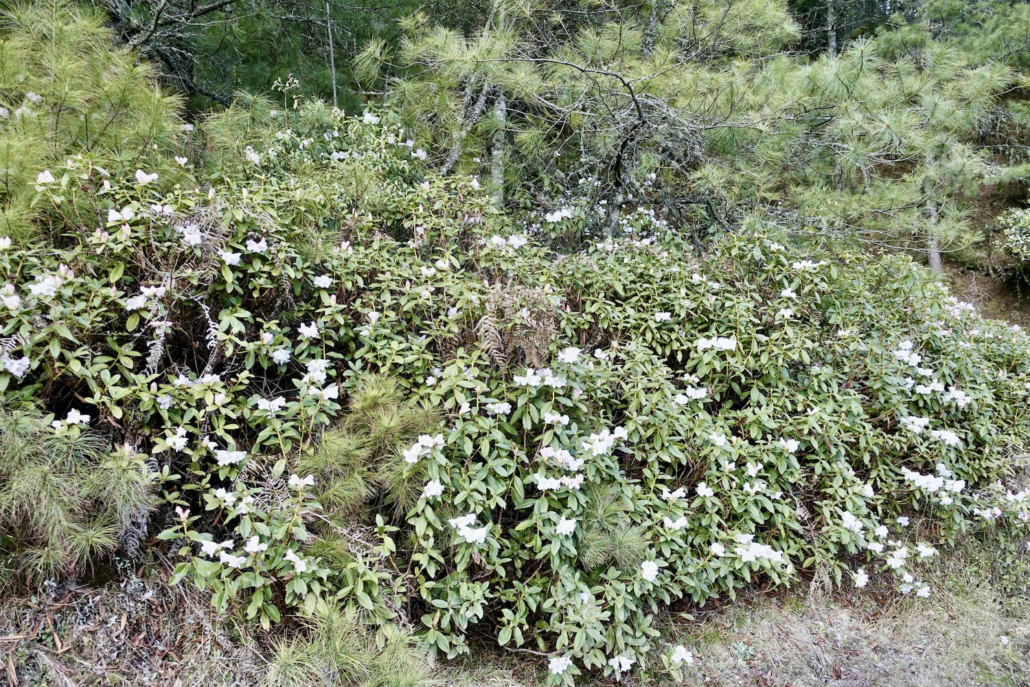
The most popular one is the Gangtey Nature Trail, starting at the Gangtey Monastery. The path winds down through rather flat terrain and ends at the bottom of the valley. You pass pastures, farmhouses and pine forests before coming to a vast open space. Yet, there are many more options to explore the valley by foot, from short walks to immersive three-days treks.

4.3. Gangtey Monastery Phobjikha Valley
The Gangtey Monastery, also known as Gangte Goenpa, is located in a privileged situation at the top of a hill. From here, you can overlook the green expanse of the whole Phobjikha Valley. The monastery, founded in the 17th century, was restored from 2001 to 2008 due to a beetle-larvae infestation. Adjacent to the monastery you find a village where the monks’ families live.

Looking back and forward on my blog
My mini series to Bhutan started with a travel guide for this magic land of fluttering prayer flags, peaceful monasteries and red robed monks. The current post went into the perfect Bhutan 9-day itinerary through four valleys in the country’s west – Paro, Thimphu, Punakha and Phobjikha – the region that most first time travelers visit in this Himalayan nation.
Next on my blog will be a comparison of the three luxury hotels that offer Bhutan itineraries. After this, I give details on our journey through the Land of the Thunder Dragon, arranged by one of these, COMO.
My Bhutan mini series will find an end with outlining opportunities for a pre- and post-stay. This is a necessity because it is usually not possible to reach Druk Yul – yet another name for Bhutan – without a layover, at least when coming from far-away countries.

Date of visit: April 2023
Pin it for later

The post Bhutan in the Himalayas, a perfect 9-day itinerary first appeared on Swiss Traveler

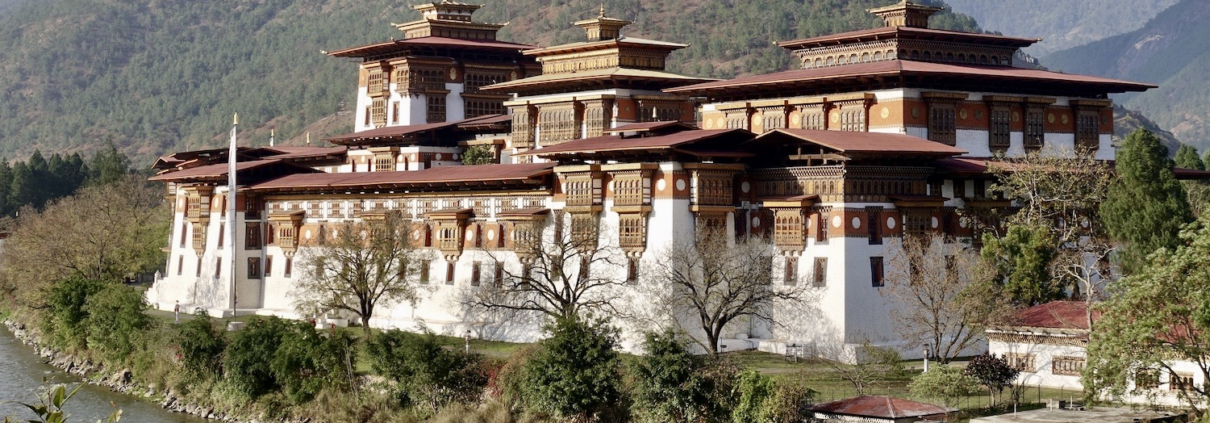




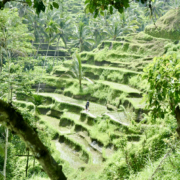
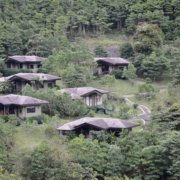


Leave a Reply
Want to join the discussion?Feel free to contribute!